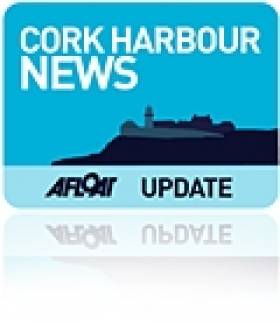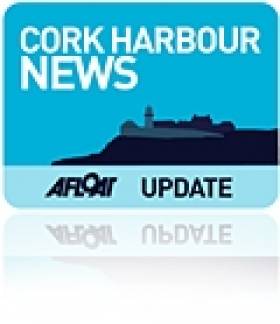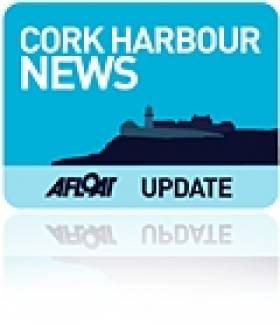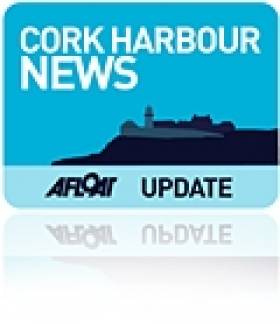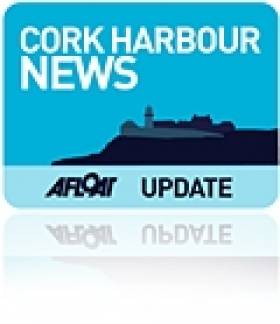Displaying items by tag: Cork Harbour News
#EmerSailsAway – As previously reported, M.V. Emer which departed Cork for the final time yesterday, has set a course bound for Nigeria, to begin a first-time change in her career since commissioning into Naval Service in 1978, writes Jehan Ashmore.
She no longer has her naval prefix of L.É. (Long Éireannach -'Gaelic' for Irish Ship) nor indeed P21 boldly across her bows, however her owners, Uniglobe International Service (UIS) which acquired the former OPV last Autumn have retained her original name.
The origins to the vessels name of Emer are to the principal wife of Cúchulainn and the daughter of a chieftain. Her owners cite it would be a shame to change her name after all these years in a career which spanned almost 35 years.
Numerous patrol duties were carried out in Irish waters and to those carried far out into the Atlantic and often in stormy seas. Over the years she was upgraded with advances in technology yet the passage of time saw her life-span reach to a stage requiring replacement.
This is where newbuild OPV L.É. Samuel Beckett (P61) is designed to cope in worsening sea-states and in patrolling considerably larger sea areas zones from that of the era of Emer's debut in the late 1970's.
In addition, the demands of the navy's remit in carrying out multi-task duties will see use of state of the art technology. Notably through the deployment of drones will greatly improve performance operability.
As she was the oldest in the Naval Service fleet, L.É. Emer served the nation carrying out not just routine fishery patrol duties of the EEZ, but the wide variety of tasks in which this arm of the state has proven to be vital in terms of not just governing our sovereignty but also assisting those abroad in troubled regions.
L.É. Emer and her sisters, Aoife (P22) to be sold at auction and Aisling (P23) carried out re-supply missions to Irish troops, among them Lebanon during UN mandated missions.
On her final patrol as previously reported was under the command of Lt Cdr Alan O'Regan, Officer Commanding and this saw her make farewell calls to sevarel ports last September. Among them the capital after the Dublin FlightFest event, in which she acted as a co-ordination centre as well to host ship duties.
This will contrast to her new career in which her role will be in entering the charter market in the oil-field industry which will involve transferring technicians and workers to platforms. In addition to transporting inspector's and auditors to installations and others associated in the energy and exploration industry.
In the meantime, her delivery voyage to waters off the mid-western African state, will involve a slow steaming-fuel efficient passage taking approximately 3 weeks to complete.
As depicted in our last report, the photograph of Emer shows her in lower Cork Harbour, off the Whitegate Oil Refinery, before she made bid her final farewell off Roches Point Lighthouse.
Take a closer look to her reveal another hint of her new identity as the owners name is abbreviated to 'UIS' which can be seen on the funnel casing.
While the grey superstructure and hull remain however the vessel will be in very unfamiliar waters. From the Atlantic seaboard to that off the continent of Africa.
‘Emer’ Finally Departs Cork Bound for Nigerian Service
#EmerSailsAway – The former Naval Service OPV ship, L.E. Emer, set sail yesterday from Cork Harbour bound for Nigeria, having completed dry-docking work following her sale last year, writes Jehan Ashmore.
No longer a naval vessel and her prefix of L.E. replaced to that of M.V. Emer. Yet she retains her grey colours as she departed Cork Harbour for the final time, from where she was based out of the naval base of Haulbolwine for almost 35 years. As previously reported, she was sold last October to Uniglobe Group for €320,000.
Her departure fell on yesterday's twinning of the Naval Service's newest addition, L.E. Samuel Beckett (P61) with her adopted city of Cork. She is the first of a pair of newbuild replacements, in which the leadship directly replaced the ageing L.E. Emer (P21) completed in 1978. She was launched at Verolme Cork Dockyard in Rushbrooke near Cobh.
As for her direct successor, L.E. Samuel Beckett will be open to the public this afternoon (3-5pm) while berthed at Kennedy Quay in the heart of Cork's docklands, where photos of the twinning ceremony are available HERE.
Emer's setting out to sea yesterday was for the first time since work started last Autumn in Cork Dockyard, from where she was launched in 1978 as the first of the 'Emer' class. She was an improved version of L.E. Deirdre, the first custom built vessel for the Irish Navy when launched in 1972.
After conducting several evolutions and exercises on proving systems, the Emer was released to make its way to long journey to her owners in Nigeria, along the mid-west African coast.
Around this time next year, L.E. James Joyce is expected to be delivered to the Naval Service and to replace one of the two remaining 'Emer' class, the L.E. Aoife which is also to be auctioned.
The final sister of the Emer trio, L.E. Aisling and the flagship L.E. Eithne will then be the only members left of the 8-strong fleet to be custom built from an Irish shipyard.
National Maritime Training College Lands US Deal
#MaritimeCollegeDeal- The Irish Examiner writes that the National Maritime College of Ireland (NMMI) will sign a landmark €2m training contract with one of the world's largest shipping companies in Texas.
The deal between the global giant Chevron Shipping Company and GAC Training and Service Solutions (GTSS) — a joint venture between the NMMI in Co Cork and GAC, a global shipping, logistics and marine services provider — is the single largest maritime training contract in the history of the Irish State.
It will result in the maritime college delivering a range of training courses to about 450 Chevron Shipping officers from around the world at its state-of-the-art Ringaskiddy facility — a constituent college of Cork Institute of Technology — over the next four years.
The courses will include skills training for Chevron's entire junior officer corps, and engine room workshop skills for its junior engineers. Click here, for more on this story.
Cork Harbour Open Weekend – Look Out for the ‘Flagships’
#CorkHarbour – As previously reported the Cork Harbour Open Weekend which began today is packed with lots of free activities for all the family to see and enjoy throughout the natural harbour, writes Jehan Ashmore.
As previously reported, due to operational reasons, unfortunately the Naval Service are unable to provide the L.E. Orla (P41) for public tours at City Quay as part of this weekend's Cork Harbour Open Weekend.
Should you however be taking an excursion to Cobh today, notably two flagships, one belonging to a French ferry firm, the other a German cruise company will be in local waters.
The impressive flagship Pont-Aven (2003/44,000grt) of Brittany Ferries is a cruise ferry that is scheduled to pass off Cobh from 16.00hrs onwards. The Breton based ferry company celebrates 35 years of service running between Cork Harbour to Roscoff.
Approximately two hours later at 18.00hrs the other flagship, the Amadea (1991/29,008grt) of German cruise operator Pheonix Reisen is set to depart Cobh's deepwater quay. As previously reported she sailed last night from Foynes as part of a cruise to include Irish ports.
Prior to these ship movements there will be an air/sea rescue demonstration early this afternoon at 14.30hrs and held in the lower harbour carried out by the Irish Coastguard. This is a super spectacle for everyone to watch from the shoreline and see the incredible work carried out by our Coastguard.
At the Cobh Heritage Centre the Cork Dockyard Photographic Exhibition continues with a display of around 200 photographs which is a must for those interested in the history of local shipbuilding. The exhibition which is admission free is open today and closes tomorrow.
On Sunday at 14.00hrs there will be an event for anyone with an interest in the Lusitania tragedy. Local historian Jack Gilmartin will attend the Lusitania graves in the Old Church Cemetery in Cobh and outline the town's links with the tragedy of the sinking of the Lusitania in 1915.
For further information on the Port of Cork Open Weekend visit the programme www.corkharbour.ie or to download a PDF version of events click HERE.
Cork Harbour Open Weekend Plays Host to Maritime Events
#CorkHarbour – The Cork Harbour Open Weekend takes place on 14-15 September and once again organisers promise it to be an excellent weekend of fun for all the family, with many events held free of charge to the public.
The open weekend is a great opportunity for people to see exactly what Cork Harbour has to offer, and this year will be no exception with the second largest natural harbour in the world playing host too many different activities.
Events will take place in Cobh, Crosshaven, Ringaskiddy, Monkstown, Camden Fort Meagher, Spike Island and Cork City, spanning the entire harbour and showcasing all the best in Maritime heritage.
This year sees the return of the popular hop-on hop-off boat tour, free tours of an Irish Naval vessel will also be open to the public for both days in Cork City.
Organisers, the Port of Cork Company and Cork County Council are particularly excited about the raft race organised by the scouts on the River Lee which no doubt will be a great spectacle from Cork City quays.
While the programme of events is still coming together, organisers confirmed there will be an open day in the RCYC for anyone keen to try out sailing.
There's also a children's crab fishing competition in Cobh, a free open day at the National Maritime College of Ireland (NMCI), a rowing race around Spike Island, an Air Sea Rescue Demonstration and family fun on Spike Island.
Click link to download copy of the programme and the promotional poster.
Follow events on www.corkharbour.ie, Facebook and on Twitter @corkharbour using the hashtag #corkharbour13
#VerolmeWeekend – To mark the finale of Cork Dockyard Workers Gathering Weekend, the last Mayor of Cobh Town Council, John Mulvihill Jnr, attended yesterday a plaque unveiling dedicated to shipyard workers to include Verolme Cork Dockyard in Rushbrooke, writes Jehan Ashmore.
Among the large crowd of former VCD employees, family and friends, was John Brennan who was master of ceremonies at Cork Dockyard, (formely VCD) which is a ship-repair only facility that is part of the Doyle Shipping Group.
Conor Doyle of the Doyle Group spoke of the wonderful history of shipbuilding in Cork Harbour and he said the group remained committed to the dockyard which has the 'potential' for further development should the demands from the offshore energy industry require.
During the proceedings, poetry and song celebrated the lives and workers of shipbuilding yards throughout Cork Harbour in a history that stretches beyond VCD's formation in 1959 but back to 1860.
An anchor was restored recently for the memorial occasion and where a bottle of champagne was smashed against it by Delia Webster of Cobh Tourism.
The Port of Cork, Cork Dockyard, Cobh Tourism and Irish Rail organised the commemorative weekend which involved a shipping lecture programme held in the Commodore Hotel, tours of L.E. Aoife alongside Cobh's waterfront. A mass in St. Colman's Cathedral was held and where a baptismal font was restored by former VCD staff.
Also part of the weekend was a photographic exhibition of ships built at VCD which remains open to the public in the Cobh Heritage Centre until 15 September.
The commemorative plaque was unveiled by Henk Ven der Puil, son of the late Gerard Van Der Puil, Managing Director of VCD. Father Michael Leamey performed a blessing of the plaque..
At its prime VCD employed more than 1,200 people working in ship-building, ship-repair, offshore platform modules and many other engineering enterprises.
During its quarter century existence, VCD built a total of 33 vessels, mostly for Irish concerns, among them Irish Shipping Ltd (ISL), B+I Line (including the last 'Leinster' as previously posted), Arklow Shipping and overseas clients and notably the bulker Irena Dan.
Naval ship LE Niamh in dry dock. Photo: Jehan Ashmore
The first vessel built was Irish Rowan, other ships built for ISL included the 75,000dwt Irish Spruce, a 'Panamax' bulker completed in the early 1970s.
L.E. Eithne (P31) was commissioned as the last vessel out of five built for the Naval Service and indeed she is also the last ever ship to be launched from the Rushbrooke shipyard in 1984.
Following the plaque unveiling, nostalgic tours of the dockyard took place which included access to the large series of building halls, the ship launch slipways and dry-dock / graving dock, where the Naval Service OPV L.E. Niamh (P52) was undergoing an overhaul.
The building halls. Photo: Jehan Ashmore
The remaining cranes. Photo: Jehan Ashmore
Naval Vessel Tours, An Example of Verolme Cork Dockyard Built Ship
#VerolmeWeekend – The Naval Service OPV L.E. Aoife (P22) which this week detained a UK registered trawler, is to be open for public tours at Cobh Deepwater Quay, as part of Cork Dockyard Workers Gathering this weekend, writes Jehan Ashmore.
Tours (2-5pm) of the Verolme Cork Dockyard built vessel commissioned in 1979 will provide access to view the second of the trio of 'Emer' offshore patrol vessels.
The leadship of this class L.E. Emer (P21) completed in 1978, is to perform her final patrol next month. As previously reported on Afloat.ie she is to be put up for public auction, if not previously sold, in late September 2013 and LE Aoife is to follow suit a year later.
The L.E. Emer and her sisters are a derivative of L.E. Deirdre (P20) and which saw the trio of OPV's modified to improve stability and increased speed. The 'Emer' class were also fitted with a bow thruster to improve manoeuvrability especially in confined waters. Noting, the 'Deirdre's bow which has a more pronounced flare compared to her newer sisters.
L.E. Deirdre was the first custom-built vessel commissioned for the Naval Service when she was launched in 1972. She was decommissioned in 2001 and sold for €190,000. She was then converted into a luxury private yacht, Santa Maria, for more details visit this Facebook page.
Of the remaining trio, L.E.Aisling (P23) dating from 1980 is the youngest. She will be retained when the pair of OPV's which are been built by Babcock Marine, Appledore in north Devon enter service in 2014 and 2015 to replace L.E. Emer and L.E. Aoife.
The newbuilds are to break with tradition as reported in that they will be named after male literary figures (L.E. Samuel Beckett and L.E. James Joyce) rather than female mythical figures.
When these newbuilds enter service they will maintain the eight-strong fleet which includes the 'flagship' L.E. Eithne (P31).
As reported earlier today, she represents the last vessel commissioned for the navy by VCD and indeed is the final ship ever to be launched from the shipyard in Rushbrooke in 1984.
During its quarter century existence, VCD built a total of 33 vessels, mostly for Irish concerns, among them Irish Shipping Ltd, B+I Line, Arklow Shipping and a handful of overseas clients to include Sealink / British Rails' 'Freightliner' division.
Cork Dockyard Gathering Weekend: Lecture Seminar Programme
#VerolmeWeekend – As part of the Cork Dockyard Gathering Weekend as previously reported, a lecture seminar is to be held in Cobh's Commodore Hotel this Saturday 24 August.
Former employees of Verolme Cork Dockyard (VCD) in Rushbrooke, Cobh and their families and the public are being invited to take a trip down memory lane to celebrate 150 years of the glory days shipbuilding and repair. For a list of shipping related lectures at the seminar, see below.
At its peak VCD employed over 1200 personnel and closed in 1984 with the last ship built at the yard the L.E. Eithne (P31) completed for the Naval Service. The site currently maintains a ship repair business operated by Cobh Dockyard.
As reported earlier, at the official opening of the Cork Dockyard photograph exhibition in Cobh, Captain Michael McCarthy Commercial Manager Port of Cork commented that he believed that Cork Dockyard has a potentially vibrant future particularly in the offshore oil and gas support role, offshore wind energy and wave and tidal.
He said: "Although it may never return to its former glory days in shipbuilding, I can see its potential in employment for our young people and training prospects. It is still one of the most unique facilities in the country and when we see how Harland and Wolfe capitalised on their asset, it is very important that we keep an open mind on its undoubted potential."
Tomorrow morning an opening ceremony of the Cork Dockyard Weekend will be held at 11 am on Cobh's Promenade. This will be followed by the lecture seminar (1-6pm) hosted in the Cobh waterfront hotel's Jack Doyle Room. Below is a listing and times of the FREE lectures.
13.00hrs: The History of the Irish Navy Service - Cmdr. Steve Walsh, Operations Command, Naval Base, Haulbowline.
14.00hrs: Irish Shipping Ltd: The First Fifteen Ships – Rosslare Maritime Enthusiasts
15.45hrs: Tea-Break
16.00hrs: Launching of a Ship - John Brennan
16.40hrs: Heavy Lifting Platforms - Capt. Pat Murphy, Port of Cork
17.20hrs: History of Port of Cork - Capt. Pat Farnan.
18.00hrs: Close
Immediately after the lectures on the Saturday there will be an informal social evening in the Commodore Hotel, commencing with a performance by local sea shanty group Molgoggers.
For further details of other events organised throughout the weekend, visit this previous report.
#CorkHarbour – The increasing strategic importance of Cork Harbour as a base for the oil and gas energy sector in the search for natural resources particularly off our southern shores, is evident with this recent view taken by our colleagues of the platform supply vessel (PSV) Bourbon Clear passing Cobh, writes Jehan Ashmore.
Not only is Bourbon Clear painted with a distinctive green hull but also features an unconventional bow which is of the X-BOW design, a unique and environmentally-friendly hull line design that is patented by her Norwegian developers Ulstein.
The odd looking X-Bow has an inverted bow design which was first introduced in 2005 with the Bourbon Orca, her introduction caused quite a splash in the offshore maritime world and beyond.
Since then, more 60 vessels of various designs have been completed with the specialist bow form which claims to improve handling in rough seas and in reduced levels of fuel consumption.
The 4,000 tonnes newbuild has further Nordic connections as the owners are Bourbon Offshore Norway. The company have a fleet of vessels that utilizise in the very latest design and technology so to provide supplies to oil and oil-related companies all over the world.

Bourbon Clear passes Port Control at 'The Holy Ground' area of Cork Harbour. Photo: Bob Bateman
Currently Bourbon have newbuilds under construction and they are of the Ulstein PX105 PSV design in which the 80m Bourbon Clear belongs to this series having been launched last year from a Chinese shipyard.
Bourbon Clear has called previously to Cobh Cruise Terminal and in the background of the (TOP) photo, is yet another Norwegian flagged vessel, Hurtigruten's Fram, the polar expedition cruiseship which visited Dublin Port yesterday.
Port of Cork CEO, Brendan Keating Announced as 'Logistics and Transport Leader' for 2013
#portofcork – Brendan Keating, CEO of the Port of Cork was announced as the winner of the 'Logistics and Transport Leader Award' at the annual Irish Logistics and Transport Awards which took place in the Burlington Hotel, Dublin with over 400 of Ireland's leading transport and logistics professionals in attendance.
Accepting the award, Mr Keating acknowledged the critical value of trade to the Irish economy, with the value of Irish export receipts in 2012 amounting to €177 billion and imports in the same year totalling €13 billion. These figures clearly illustrate the extent of trading activity in Ireland but more importantly show that Ireland is an active player and significant contributor to the process of globalisation of world trade.
Commenting on the significant role that ports play in the supply chain process, Mr Keating remarked "97% of the country's trade in terms of volume transits through our ports so it is critical that port infrastructure in Ireland has the capacity to handle growing volumes of trade. Equally important is ensuring that services provided are competitive while remaining effective and responsive.
"We must ensure that our core ports play an integral role in the delivery of effective supply chain solutions by managing and coordinating the flow of materials, commodities and information" he continued.
While a number of Irish businesses today are focused on driving down supply chain costs, significant risks and vulnerabilities often arise where the sole focus is cost reductions. Brendan Keating concluded by calling on the logistics and transport sector in Ireland to develop a comprehensive risk assessment tool kit which would help manufacturing and other businesses who are heavily reliant on their supply chain for the on-going viability of their business.



























